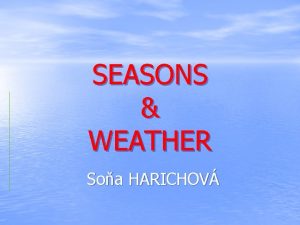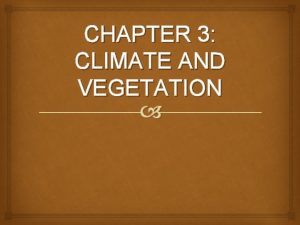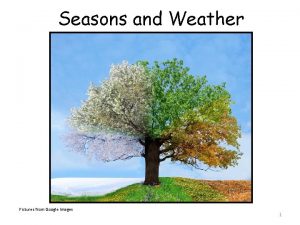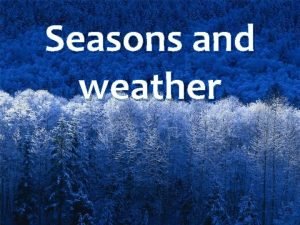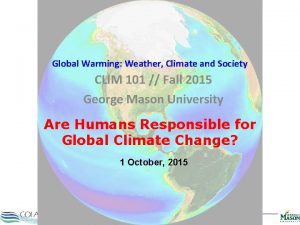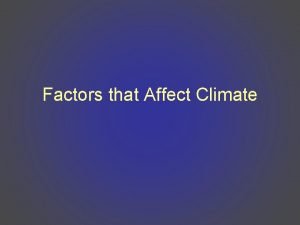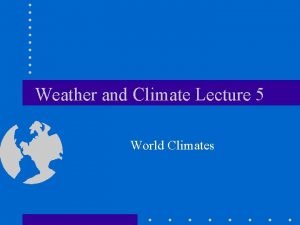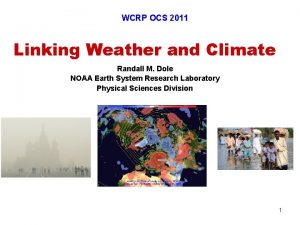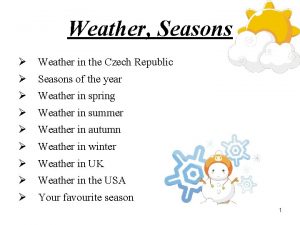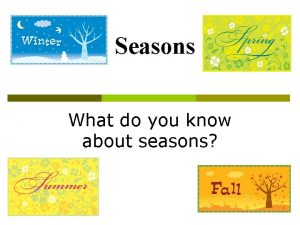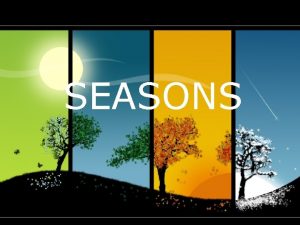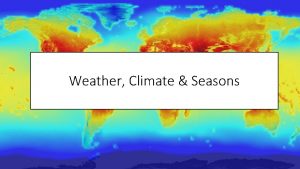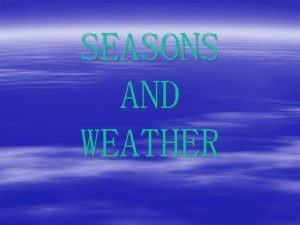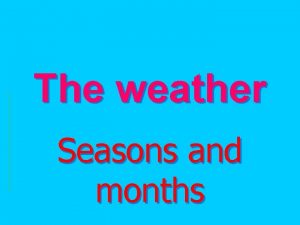Climate and Seasons Weather vs Climate Weather what











- Slides: 11

Climate and Seasons

Weather vs Climate �Weather – what is happening in the atmosphere at a particular place at a particular moment. �Climate – is the average weather in an area over a long period of time. Climate is determined by a variety of factors ▪ Latitude ▪ Air circulation ▪ Ocean currents ▪ Local geography

Latitude �Latitude is the most important factor of climate!! �Affects the amount of solar energy (heat) an area receives.

Air Circulation �Cold air sinks and warms as it sinks �Warm air rises and cools as it rises �Warm air can hold more moisture than cold air. Solar energy warms the air closest to Earth’s surface causing it to rise. The rising air is replaced by cooler air flowing from the north. – Circulation cell!

Ocean Currents �Remember – water holds a lot of heat! �The currents redistribute warm and cool masses of water. �Oceans make the coastal climates more moderate. Local Geography �Mountains and elevation changes can alter the climate at a given location. �Temperatures decrease as you go higher in elevation �Mountains also influence precipitation patters and air has to rise and thus cool and lose precipitation to pass over a mountain.

� Which of these factors MOST influence a regions climate? A. Number of forests B. Distance from an ocean C. Number of mountain ranges D. Distance from the equator

Thermal Inversion � Normal higher air is cooler � Thermal inversion occurs when the air above is warmer than the surface air. � This can trap pollutants near the Earth’s surface! � Cities in a valley have a greater chance of experiencing this!

� Thermal inversion is A. like a sponge soaking up pollutants. B. like a giant fan, causing pollutants to disperse. C. like a ceiling, preventing pollutants from moving upward. D. something that happens only in Los Angeles.

�Seasons are a result of Earth’s tilt as it rotates around the Sun. �The tilt affects the angle that the sun hits the Earth. Seasons

� Which of the following is NOT an adverse effect of high levels of UV light? A. Increased incidence of skin cancer B. Increased photosynthesis C. Disruption of food chains D. Increased amount of atmospheric carbon dioxide

�On the graph above what is casing the rapid fluctuations each year? Look at the annual cycle inset. A. Increased photosynthesis in the winter months. B. Increased photosynthesis during summer months. C. Increased cellular respiration during summer months D. More births and thus more people during winter months.
 Climate seasons
Climate seasons Seasons and weather
Seasons and weather Continental location
Continental location Weather seasons in usa
Weather seasons in usa Images of seasons
Images of seasons Four seasons weather
Four seasons weather Climate change 2014 mitigation of climate change
Climate change 2014 mitigation of climate change World geography chapter 3 weather and climate
World geography chapter 3 weather and climate Weather climate and society
Weather climate and society What is this
What is this Weather and climate similarities
Weather and climate similarities Conclusion of weather and climate
Conclusion of weather and climate

